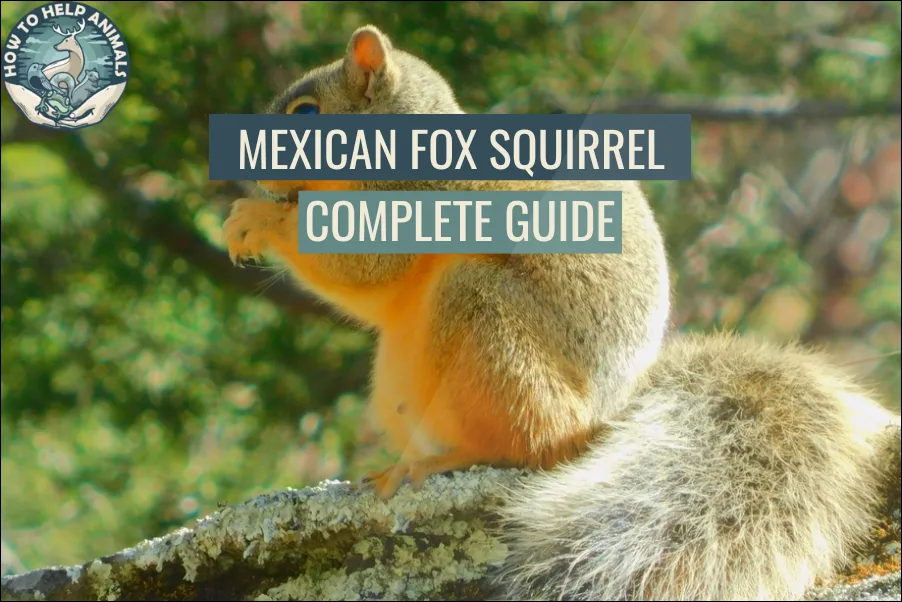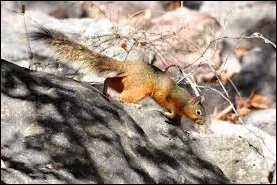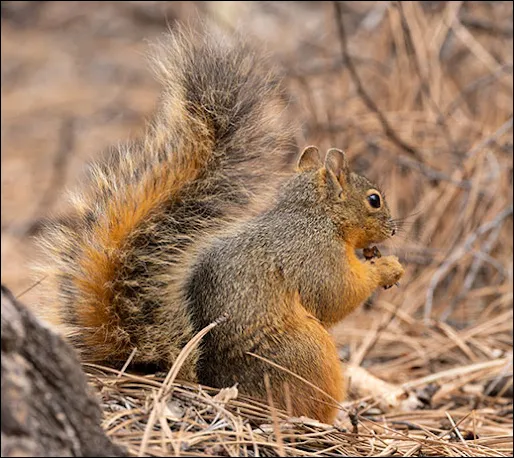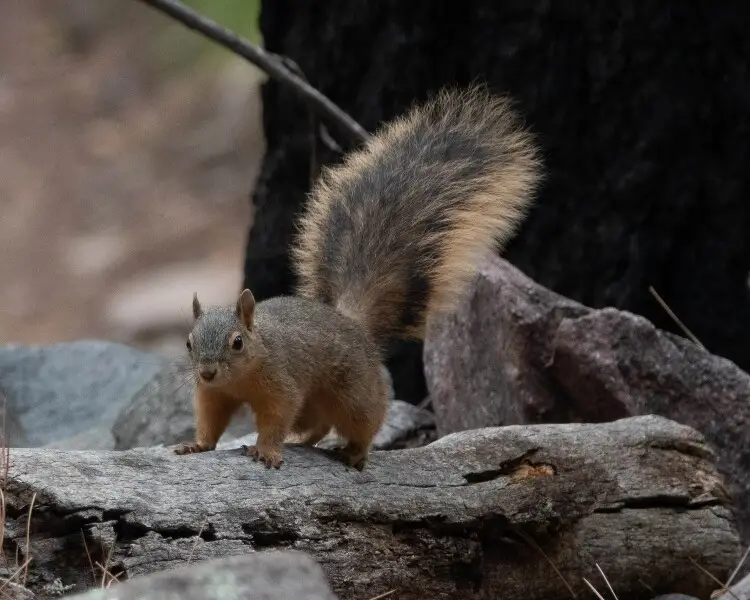
The Sierra Madre morning mist clings to ancient pine and oak forests as a flash of silver-gray catches your attention high in a massive Chihuahua pine. This elusive creature, larger and more robust than any squirrel you’ve encountered, moves with deliberate grace through the cloud forest canopy. You’re witnessing one of North America’s rarest and least-known tree squirrels – the Mexican Fox Squirrel, a magnificent species that bridges tropical and temperate worlds in the sky islands of Mexico and the borderland mountains of the American Southwest.
The Mexican Fox Squirrel (Sciurus nayaritensis) is North America’s most mysterious large tree squirrel, distinguished by its impressive size, silvery-gray coloration, and occupation of high-elevation pine-oak forests from western Mexico into the borderlands of Arizona and New Mexico. Unlike the ponderosa pine specialist Abert’s Squirrel, the territorial American Red Squirrel, the coastal Douglas Squirrel, or the adaptable Fox Squirrel and Eastern Gray Squirrel found across much of North America, Mexican Fox Squirrels represent a unique evolutionary lineage adapted to the biodiversity hotspots of Mexico’s mountain forests.
| Attribute | Details |
|---|---|
| Scientific Name | Sciurus nayaritensis |
| Size | 20-26 inches total length |
| Weight | 600-900 grams (1.3-2.0 lbs) |
| Lifespan | 7-12 years wild, up to 18 years maximum |
| Habitat | Pine-oak forests, 5,000-10,000 feet elevation |
| Diet | Generalist: pine nuts, acorns, fungi, fruits, insects |
| Activity | Diurnal (most active morning and late afternoon) |
| Conservation Status | Data Deficient (limited population data) |
Physical Description & Identification
Impressive Size and Robust Build
Mexican Fox Squirrels rank among North America’s largest tree squirrels, with a substantial build that rivals or exceeds the impressive Fox Squirrels found across the eastern United States while displaying proportions similar to the robust Western Gray Squirrels of Pacific Coast forests. Measuring 20-26 inches from nose to tail tip and weighing 600-900 grams, they significantly outsize the specialized Abert’s Squirrel that shares portions of their range.
Their substantial build reflects adaptations for life in Mexico’s diverse mountain forest ecosystems, where larger body size provides advantages for accessing resources across varied tree species and maintaining body temperature during cool mountain nights. Unlike the compact, energy-efficient builds of smaller territorial species like American Red Squirrels and Douglas Squirrels, Mexican Fox Squirrels display the robust proportions necessary for thriving in complex, multi-species forest environments.
Their impressive tail often appears proportionally larger than those of other large squirrel species, creating a magnificent plume that serves multiple functions in their challenging mountain forest environment, from balance during long leaps between diverse tree species to communication across the varied terrain of Mexican mountain landscapes.

Distinctive Coloration and Regional Variations
Classic Coloration Pattern: Mexican Fox Squirrels typically display a striking silvery-gray to grizzled gray dorsal coloration that distinguishes them from all other large North American tree squirrels. Individual hairs show banding patterns of white, gray, and black that create an almost metallic sheen in bright sunlight, giving them a distinctive appearance unlike the rust-orange of typical Fox Squirrels or the solid silver-gray of Western Gray Squirrels.
Seasonal Coat Changes:
Summer Coat (April-September): Summer pelage displays the classic silvery-gray coloration with a clean white to cream-colored underside that extends from chin to tail base. The contrast between the grizzled gray back and pristine white belly creates one of the most elegant color patterns among North American tree squirrels.
Winter Coat (October-March): Winter pelage grows considerably denser and often shows more brownish tones mixed with the silvery-gray, while maintaining the distinctive white underside. The tail becomes particularly full and luxurious during winter months, creating an impressive plume that rivals the magnificent tails of Abert’s Squirrels.
Geographic Variations: Across their range through Mexico’s Sierra Madre and into the southwestern United States, Mexican Fox Squirrels show subtle but consistent regional variations:
- Northern populations (Arizona/New Mexico border): More grayish coloration with prominent white undersides
- Central Sierra Madre: Classic silvery-gray with occasional brownish tones
- Southern Sierra Madre: More brownish-gray coloration with less prominent silvery tones
- Pacific slope populations: Often darker and more saturated colors
- Interior mountain populations: Lighter, more silvery appearance

Distinguishing Features and Identification
Comparison with Other Large Western Squirrels:
Versus Abert’s Squirrels:
- Ear characteristics: No prominent ear tufts vs. dramatic black ear tufts
- Tail pattern: Solid silvery-gray vs. black and white banding
- Habitat overlap: Mixed pine-oak forests vs. pure ponderosa pine forests
- Size: Similar to slightly larger body size
- Behavior: Less specialized feeding vs. extreme ponderosa pine specialization
Versus Western Gray Squirrels:
- Geographic range: Mexican mountains vs. Pacific Coast regions
- Habitat preferences: Pine-oak forests vs. oak woodlands and coastal forests
- Coloration subtleties: More grizzled appearance vs. cleaner silver-gray
- Size comparison: Similar size but different proportions
- Tail characteristics: Different tail textures and movement patterns
Versus Fox Squirrels:
- Coloration: Consistent silvery-gray vs. highly variable orange/gray/black morphs
- Geographic range: Mexican mountains vs. eastern/central North America
- Habitat specialization: Mountain forest specialist vs. habitat generalist
- Body proportions: More compact build vs. varied Fox Squirrel builds
- Behavioral differences: Different territorial and social systems
Unique Physical Adaptations:
- Enhanced cold tolerance: Physiological adaptations for high-elevation Mexican mountains
- Altitude adaptations: Enhanced oxygen processing for thin mountain air
- Diverse forest navigation: Physical adaptations for varied tree species and forest structures
- Powerful jaw muscles: Capable of processing diverse nuts and seeds from multiple tree species
- Flexible dietary anatomy: Digestive adaptations allowing exploitation of varied food sources
Behavioral Identification:
- Deliberate movements: Careful, measured locomotion through diverse forest canopies
- Multi-species foraging: Feeding behaviors adapted to varied tree species
- Cautious demeanor: More secretive and wary than most other large squirrel species
- Elevation preferences: Consistent association with higher elevation forest zones
- Social flexibility: Variable social behaviors adapted to resource distribution patterns
Habitat & Distribution
Sierra Madre Mountain Range Specialization
Mexican Fox Squirrels occupy one of the most biogeographically complex and ecologically diverse ranges among North American tree squirrels, distributed throughout Mexico’s Sierra Madre mountain systems and extending into the borderland mountains of Arizona and New Mexico. Their range represents a unique combination of Neotropical and Nearctic biogeographic influences, creating habitat complexity far exceeding the more straightforward ranges of Eastern Gray Squirrels, Fox Squirrels, or even the specialized Abert’s Squirrels.
This distribution pattern reflects their evolution within Mexico’s biodiversity hotspot regions, where complex topography and varied climate zones create opportunities for ecological specialization unknown in the more uniform environments occupied by American Red Squirrels or Douglas Squirrels. Unlike species with straightforward habitat requirements, Mexican Fox Squirrels have adapted to utilize the diverse forest types characteristic of Mexico’s mountain regions.
Geographic Distribution:
- Western Sierra Madre (Mexico): Primary range through Sonora, Chihuahua, and Durango
- Eastern Sierra Madre (Mexico): Secondary populations in Nuevo León and Coahuila
- Trans-Mexican Volcanic Belt: Isolated populations in central Mexican mountains
- Arizona borderlands: Limited populations in Chiricahua and Santa Rita Mountains
- New Mexico borderlands: Small populations in Animas and Peloncillo Mountains
- Elevation range: 5,000-10,000 feet (optimal 6,500-8,500 feet)
Pine-Oak Forest Ecosystem Mastery
Mixed Forest Habitat Specialization: Mexican Fox Squirrels demonstrate remarkable adaptability within pine-oak forest ecosystems that combine temperate and subtropical elements, creating habitat complexity far exceeding the single-species focus of Abert’s Squirrels or the more uniform forest types utilized by Douglas Squirrels and American Red Squirrels.
Critical Habitat Characteristics:
- Mixed species composition: Forests combining pines, oaks, and occasional tropical elements
- Elevation complexity: Varied topography creating diverse microclimates and forest types
- Seasonal water availability: Access to permanent or seasonal water sources
- Mature forest structure: Preference for forests with large-diameter trees and complex canopies
- Minimal human disturbance: Requirement for relatively undisturbed mountain forest environments
- Connectivity corridors: Forest connections enabling movement between habitat patches
Key Tree Species Associations:
- Chihuahua pine (Pinus leiophylla): Primary conifer species providing food and shelter
- Apache pine (Pinus engelmannii): Important at higher elevations
- Mexican white pine (Pinus ayacahuite): Valuable for large seed resources
- Encino oaks (Quercus species): Multiple oak species providing acorn crops
- Madrone (Arbutus species): Supplemental fruit and shelter resources
- Mexican fir (Abies species): Occasional habitat component at highest elevations
Biogeographic Complexity and Sky Island Ecology
Sky Island Adaptations: Mexican Fox Squirrels have evolved within Mexico’s “sky island” mountain ranges – isolated peaks rising from desert valleys that create unique evolutionary laboratories for endemic species development. This biogeographic pattern creates population dynamics and habitat requirements completely different from the continuous forest ranges utilized by Eastern Gray Squirrels or Fox Squirrels.
Sky Island Characteristics:
- Isolated mountain peaks: Forest habitat surrounded by desert lowlands
- Elevation gradients: Rapid habitat changes with elevation
- Endemic species assemblages: Unique plant and animal communities on each mountain range
- Climate refugia: Mountains serving as refuges during climate changes
- Limited connectivity: Restricted movement between mountain ranges
Elevation and Climate Zonation:
- Lower montane (5,000-7,000 feet): Pine-oak transition zones with mixed forest composition
- Montane (7,000-8,500 feet): Optimal habitat with mature pine-oak forests
- Upper montane (8,500-10,000 feet): High-elevation pine forests with occasional fir
- Cloud forest zones: Moisture-rich environments with enhanced diversity
- Seasonal migration zones: Areas utilized during different seasonal periods

Cross-Border Conservation Challenges
International Range Management: Mexican Fox Squirrels present unique conservation challenges due to their distribution across the United States-Mexico border, requiring international cooperation for effective population management unlike the single-country ranges of most other North American tree squirrel species.
Border Region Characteristics:
- Habitat fragmentation: International boundary effects on habitat connectivity
- Different management systems: Varying conservation approaches between countries
- Limited research coordination: Challenges in conducting cross-border scientific studies
- Population connectivity: Restricted gene flow between U.S. and Mexican populations
- Varying legal protections: Different conservation statuses and protection levels
Binational Conservation Needs:
- Habitat corridor preservation: Maintaining forest connections across political boundaries
- Research collaboration: International cooperation for population studies
- Information sharing: Exchange of ecological and conservation data
- Coordinated management: Harmonized conservation strategies across borders
- Monitoring programs: Standardized population assessment methods
Regional Population Variations:
- Arizona populations: Small, isolated groups requiring intensive management
- New Mexico populations: Limited border populations with uncertain connectivity
- Sonoran populations: Core Mexican populations with better habitat connectivity
- Chihuahuan populations: Central range populations with optimal habitat
- Southern populations: Less studied populations in central Mexican mountains

Diet & Feeding Behavior
Pine-Oak Forest Dietary Diversity
Mexican Fox Squirrels display remarkable dietary flexibility adapted to the diverse pine-oak forest ecosystems of Mexico’s mountains, demonstrating feeding strategies that combine elements from both temperate and subtropical environments. Their dietary breadth exceeds the extreme specialization of Abert’s Squirrels while maintaining more focus than the broad adaptability of Fox Squirrels and Eastern Gray Squirrels.
Unlike the conifer specialization of American Red Squirrels and Douglas Squirrels, Mexican Fox Squirrels have evolved to exploit the seasonal abundance cycles of multiple tree species within complex mountain forest communities, creating feeding strategies adapted to Mexico’s unique biogeographic position.
Seasonal Dietary Patterns:
Spring Diet (March-May):
- Pine pollen: High-protein reproductive structures from multiple pine species
- Oak catkins: Early protein sources from various oak species
- Fresh pine needles: Young growth providing essential vitamins
- Tree buds: Growing points from pines, oaks, and other forest trees
- Early fungi: Spring mushrooms associated with pine and oak root systems
- Cached resources: Stored nuts and seeds from previous autumn harvest
Summer Diet (June-August):
- Developing pine cones: Immature cones from Chihuahua pine and other species
- Young acorns: Early-season oak seeds when available
- Diverse fungi: Peak mushroom season with species from multiple forest types
- Fruits and berries: Madrone berries and other native fruits
- Insects and larvae: Protein sources including beetle larvae and caterpillars
- Fresh vegetation: Limited consumption of herbs and understory plants
Autumn Diet (September-November):
- Primary focus: Intensive collection of pine nuts and acorns
- Chihuahua pine seeds: Large, nutritious seeds from primary habitat tree
- Encino acorns: Various oak species providing diverse acorn crops
- Mexican white pine nuts: Large seeds when available at higher elevations
- Late-season fungi: Autumn mushroom species extending fungal foraging
- Peak caching period: Intensive storage for winter survival
Winter Diet (December-February):
- Cached seed reliance: Primary dependence on stored pine nuts and acorns
- Inner bark consumption: Pine and oak bark during severe scarcity periods
- Remaining cone resources: Systematic use of stored conifer seeds
- Limited fresh resources: Reduced availability of fresh foods
- Opportunistic feeding: Available lichens, persistent fruits, and winter fungi
- Energy conservation: Reduced activity minimizing caloric requirements
Multi-Species Nut Processing Mastery
Mexican Fox Squirrels have developed sophisticated techniques for processing nuts and seeds from multiple tree species, displaying adaptations that exceed the single-species focus of Abert’s Squirrels while requiring greater specialization than the generalized feeding abilities of Fox Squirrels and Eastern Gray Squirrels.
Pine Seed Processing:
- Species-specific techniques: Different processing methods for various pine species
- Cone timing: Harvesting cones at optimal ripeness for each species
- Seed extraction: Efficient removal of seeds from diverse cone types
- Quality assessment: Ability to evaluate seed quality across multiple pine species
- Size adaptation: Processing techniques for seeds ranging from small to very large
Acorn Processing Diversity:
- Oak species recognition: Identification and preference ranking for different oak types
- Tannin management: Processing techniques reducing bitter compounds in acorns
- Seasonal timing: Harvesting different oak species based on ripening schedules
- Shell removal: Efficient techniques for various acorn shell thicknesses
- Storage preparation: Processing methods optimizing acorns for long-term storage
Advanced Processing Behaviors:
- Tool utilization: Use of environmental features to assist in nut processing
- Caching strategies: Species-specific storage methods for different food types
- Quality sorting: Immediate consumption vs. storage decisions based on food quality
- Seasonal optimization: Processing techniques adapted to seasonal food characteristics
- Efficiency maximization: Behavioral strategies minimizing energy expenditure
Food Storage and Territory Management
Mexican Fox Squirrels employ sophisticated food storage strategies adapted to the diverse resource patterns of pine-oak forests, creating caching systems more complex than those of American Red Squirrels and Douglas Squirrels while requiring greater organization than the scatter-caching typical of Fox Squirrels.
Diversified Caching Strategies:
- Multi-species storage: Different caching techniques for various food types
- Elevation-based caching: Strategic placement across elevation gradients
- Microhabitat selection: Cache site selection based on soil, moisture, and protection
- Seasonal cache rotation: Different storage sites for different seasons
- Risk distribution: Multiple cache locations reducing catastrophic loss potential
Territory and Resource Management:
- Large territory maintenance: Home ranges of 10-50 acres depending on habitat quality
- Resource patch management: Systematic use of different food source areas
- Flexible boundary systems: Territory adjustments based on seasonal resource availability
- Multi-elevation territories: Home ranges spanning elevation zones for diverse resources
- Social tolerance: Variable aggression levels based on resource abundance
Long-term Storage Systems:
- Multi-year accumulation: Building food supplies spanning multiple years
- Quality control: Regular inspection and maintenance of cached resources
- Inventory management: Apparent awareness of cache contents and locations
- Emergency reserves: Backup caches for catastrophic loss protection
- Access planning: Strategic cache placement ensuring year-round accessibility

Fungal Relationships and Forest Ecology
Mexican Fox Squirrels have developed complex relationships with the diverse fungal communities of pine-oak forests, creating ecological interactions that exceed the fungal specialization of Douglas Squirrels while incorporating elements unknown in the more temperate environments occupied by other North American tree squirrel species.
Mycorrhizal Forest Networks:
- Multi-species fungal partnerships: Relationships with fungi from both pine and oak forest systems
- Spore dispersal services: Supporting fungal reproduction across diverse forest communities
- Forest health contributions: Fungal dispersal supporting complex forest ecosystem functions
- Seasonal fungal exploitation: Harvesting different fungal species throughout the year
- Elevation-based fungal diversity: Utilizing fungal resources across elevation gradients
Tropical-Temperate Fungal Interface:
- Biogeographic fungal diversity: Access to both temperate and subtropical fungal species
- Unique fungal associations: Relationships with fungi found nowhere else in North America
- Climate-dependent foraging: Fungal harvesting synchronized with Mexican mountain weather patterns
- Dry season adaptations: Strategies for locating fungi during extended dry periods
- Monsoon season utilization: Peak fungal foraging during summer rainy seasons
Ecological Significance:
- Forest connectivity: Fungal dispersal maintaining connections between forest patches
- Biodiversity support: Supporting diverse fungal communities through foraging activities
- Nutrient cycling: Participation in complex mountain forest nutrient systems
- Ecosystem engineering: Behavioral activities influencing forest community structure
- Conservation importance: Role in maintaining rare and endemic fungal species

Reproduction & Life Cycle
Mountain Forest Breeding Adaptations
Mexican Fox Squirrels experience breeding patterns adapted to the complex seasonal cycles of Mexican mountain forests, with reproductive timing influenced by both temperate and subtropical climate patterns that create conditions unlike those experienced by Eastern Gray Squirrels, Fox Squirrels, or the high-elevation specialists Abert’s Squirrels.
Primary Breeding Season (February-April): Mexican Fox Squirrel breeding occurs during the dry season’s end and the beginning of spring warmth, synchronized with the gradual transition from winter dormancy to spring growth in Mexican mountain ecosystems.
Mexican Mountain Climate Influences:
- Dry season breeding: Mating during periods of low precipitation but increasing temperatures
- Elevation effects: Different breeding timing across elevation gradients
- Monsoon preparation: Breeding timed to ensure offspring development during summer rains
- Resource synchronization: Mating coordinated with emerging spring food sources
- Temperature optimization: Breeding during moderate temperature periods
Regional Breeding Variations:
- Northern populations (borderlands): Later breeding due to cooler mountain conditions
- Central Sierra Madre: Peak breeding season timing adapted to local climate patterns
- Southern populations: Earlier breeding in warmer subtropical mountain zones
- Elevation influences: Higher elevation populations showing delayed breeding
- Aspect effects: Breeding timing varying with slope orientation and solar exposure
Courtship in Diverse Mountain Forests
Mexican Fox Squirrel courtship involves behaviors adapted to the complex three-dimensional structure of pine-oak forests and the challenges of locating potential mates across large territories in biogeographically diverse mountain environments, creating courtship patterns distinct from the more uniform forest environments utilized by other North American tree squirrel species.
Pre-Mating Behaviors:
- Multi-elevation calling: Vocalizations adapted to carry across varied forest types and elevations
- Scent trail networks: Chemical communication utilizing diverse tree species for marking
- Visual displays: Tail flagging and body positioning visible across mixed forest canopies
- Territory demonstrations: Males showcasing territory quality across diverse resource patches
- Competitive interactions: Male-male competition adapted to complex terrain and varied resources
Mating Process: Female Mexican Fox Squirrels typically mate with multiple males during their 8-12 hour receptive period, ensuring genetic diversity while allowing assessment of male quality through behavioral displays and territorial success across diverse mountain forest environments.
Courtship Communication:
- Forest-adapted vocalizations: Calls optimized for mixed pine-oak forest acoustics
- Long-distance signaling: Communication across varied topography and forest structure
- Chemical communication: Scent marking utilizing multiple tree species and forest features
- Behavioral demonstrations: Agility displays showcasing adaptation to diverse forest environments
- Resource advertising: Territory quality demonstrations across multiple habitat types
Nest Construction in Complex Forest Environments
Gestation Period: 38-42 days
Nest Site Selection: Mexican Fox Squirrels face unique challenges in selecting nest sites within diverse pine-oak forests, requiring protection from varied weather patterns while providing access to multiple resource types, creating nesting requirements more complex than those faced by single-forest-type specialists like Abert’s Squirrels or Douglas Squirrels.
Diverse Cavity Utilization:
- Pine cavities: Natural hollows in various pine species
- Oak cavities: Hollows in large oak trees providing different microclimate conditions
- Mixed-species opportunities: Cavities in other forest trees when available
- Elevation-specific sites: Different nest sites for different elevation zones
- Seasonal nest variation: Multiple nests adapted to different seasonal conditions
Complex Drey Construction:
- Multi-species materials: Construction using materials from diverse forest trees
- Weather adaptation: Building techniques for varied Mexican mountain weather patterns
- Elevation considerations: Construction adapted to different elevation microclimates
- Forest diversity integration: Nest positioning utilizing varied forest structure
- Seasonal modifications: Ongoing adaptation to changing environmental conditions
Construction Material Diversity:
- Pine materials: Needles, bark, and branches from multiple pine species
- Oak components: Leaves, small branches, and bark from various oak species
- Regional materials: Use of locally available mountain forest materials
- Insulation adaptation: Materials selected for Mexican mountain temperature ranges
- Weather resistance: Material combinations for diverse precipitation patterns
Offspring Development and Mountain Adaptations
Birth Characteristics: Mexican Fox Squirrel litters typically contain 2-4 young, born after the 38-42 day gestation period, with development patterns adapted to the complex challenges of survival in diverse mountain forest environments.
Newborn Features:
- Size: Approximately 4 inches long, weighing 14-18 grams
- Appearance: Pink, hairless, with closed eyes and ears
- Development: Balanced maturation rate adapted to Mexican mountain seasonal patterns
Developmental Timeline:
Weeks 1-3:
- Rapid growth: Fast weight gain through nutrient-rich maternal milk
- Thermoregulation: Critical temperature management in mountain climates
- First silvery-gray fur: Beginning of distinctive Mexican Fox Squirrel coloration
Weeks 4-6:
- Eye opening: Eyes open around day 25-30
- Hearing development: Ear function beginning around day 27-32
- Motor coordination: Initial balance and movement development adapted to complex forest environments
- Nest exploration: Short ventures within cavity or drey structure
Weeks 7-9:
- First emergence: Initial exploration outside nest in diverse pine-oak environment
- Solid food introduction: Exposure to varied foods from multiple tree species
- Climbing instruction: Maternal teaching of navigation across diverse forest types
- Predator awareness: Education about varied mountain forest threats
Weeks 10-12:
- Weaning progression: Gradual reduction of nursing dependency
- Multi-species foraging education: Learning to process foods from various tree species
- Territory exploration: Guided tours of complex mountain forest territory
- Elevation adaptation: Education about utilizing different elevation zones
Weeks 13-16:
- Independence preparation: Extended time developing complex survival skills
- Advanced foraging skills: Mastery of processing techniques for multiple food types
- Mountain navigation: Learning elevation-based movement and resource patterns
- Social skills: Understanding of population dynamics in complex environments
Weeks 17-20:
- Dispersal readiness: Preparation for establishing individual territories
- Adult behavior development: Full expression of Mexican Fox Squirrel characteristics
- Complex territory management: Understanding of multi-resource territory systems
- Survival competency: Ability to survive independently in diverse mountain forests
Extended Maternal Investment: Mexican Fox Squirrel mothers provide exceptionally long parental care, including detailed instruction in the complex skills required for surviving as generalists within Mexico’s biodiversity hotspot mountain forest ecosystems.

Behavior & Social Structure
Flexible Social Systems in Diverse Forests
Mexican Fox Squirrels maintain social systems that reflect the complex resource distribution patterns of pine-oak forests, displaying greater flexibility than the intensive territorial behaviors of American Red Squirrels and Douglas Squirrels while showing more structure than the highly adaptable social patterns of Fox Squirrels and Eastern Gray Squirrels.
Territory and Social Organization:
- Large, resource-based territories: Home ranges of 10-50 acres organized around diverse food sources
- Flexible boundary systems: Territory boundaries adjusting to seasonal resource availability
- Elevation-based territories: Home ranges spanning multiple elevation zones for resource diversity
- Social tolerance: Variable aggression levels based on resource abundance and population density
- Neighbor recognition: Stable relationships with adjacent territory holders across diverse forest types
Adaptive Social Behaviors:
- Resource sharing: Limited tolerance for territory overlap during abundance periods
- Information networks: Indirect communication about environmental conditions and threats
- Cooperative vigilance: Shared predator detection across complex forest environments
- Seasonal aggregations: Temporary gathering in optimal resource areas during peak abundance
- Stress management: Behavioral adaptations for managing population density in limited habitat
Population Regulation:
- Density-dependent responses: Behavioral changes during high-density periods
- Dispersal mechanisms: Young squirrel movement maintaining genetic diversity
- Habitat quality correlation: Population density reflecting pine-oak forest condition
- Self-regulation: Behavioral mechanisms preventing habitat overexploitation
- Social hierarchy: Dominance systems based on territory quality and resource control
Communication in Mountain Forest Environments
Mexican Fox Squirrels have evolved communication systems adapted to the acoustic complexity of mixed pine-oak forests and the challenges of long-distance communication across diverse mountain terrain, creating vocalizations and signaling behaviors that incorporate elements from both temperate and subtropical environments.
Vocal Communication Adaptations:
Multi-Environment Calling:
- Forest-type specific calls: Vocalizations adapted to different acoustic properties of pine vs. oak forests
- Elevation-adjusted calling: Vocal modifications for different atmospheric conditions at various elevations
- Distance communication: Long-range calls spanning complex mountain topography
- Weather-adapted vocalizations: Calling patterns modified for Mexican mountain climate conditions
Acoustic Repertoire:
- Territorial calls: Low-frequency vocalizations establishing territory boundaries across diverse forest
- Contact calls: Moderate-frequency sounds maintaining social connections in complex environments
- Alarm calls: Sharp warnings adapted to varied predator threats in mountain forests
- Courtship vocalizations: Specialized calls during breeding season across elevation gradients
Visual and Chemical Communication:
- Multi-species scent marking: Chemical communication utilizing diverse tree species for marking
- Elevation-based signaling: Visual displays adapted to varied forest structure and topography
- Seasonal display variations: Communication changes based on Mexican mountain seasonal patterns
- Individual recognition: Unique signatures facilitating neighbor identification across large territories
Daily Activity Patterns in Mexican Mountains
Mexican Fox Squirrels have adapted their daily routines to the unique climate patterns of Mexican mountain forests, including seasonal monsoons, dry periods, and elevation-based temperature variations that create activity schedules different from those of squirrels in more uniform temperate environments.
Typical Mountain Daily Schedule:
Dawn Activity (Sunrise + 30 minutes to Mid-Morning):
- Temperature optimization: Activity beginning after cool mountain nights
- Multi-resource foraging: Systematic visits to different forest types and elevation zones
- Territory patrol: Morning inspection across diverse habitat components
- Social interactions: Brief encounters with neighbors across territory boundaries
Midday Behavior (Late Morning to Mid-Afternoon):
- Elevation-based rest: Seeking optimal temperature zones during midday heat
- Forest-type selection: Choosing appropriate forest areas for thermal regulation
- Grooming and maintenance: Coat care adapted to mountain forest conditions
- Cache organization: Food storage management across diverse territory areas
Evening Activity (Late Afternoon to Sunset):
- Intensive foraging: Final feeding across multiple resource patches before nightfall
- Nest preparation: Evening shelter selection based on weather and temperature predictions
- Communication peak: Vocal interactions and territory reinforcement
- Predator vigilance: Increased awareness during peak predator activity periods
Seasonal Activity Modifications:
- Dry season (October-May): Activity patterns adapted to limited water and food resources
- Monsoon season (June-September): Modified routines taking advantage of increased food and water
- Breeding season (February-April): Extended activity during courtship and mating periods
- Resource peak periods: Intensive activity during optimal food availability
Elevational Movement and Resource Tracking
Unlike most other North American tree squirrels that maintain relatively stable territories, Mexican Fox Squirrels often undertake complex movement patterns following optimal conditions and resource availability across the elevation gradients characteristic of Mexican mountain forest ecosystems.
Seasonal Movement Patterns:
- Elevation tracking: Movement following optimal temperature and resource zones
- Resource migration: Relocations based on seasonal food availability patterns
- Weather avoidance: Temporary movements during extreme Mexican mountain weather
- Breeding dispersal: Movement patterns during courtship and mating periods
- Dry season adaptations: Relocations to areas with better water and food access
Movement Triggers:
- Temperature extremes: Elevation changes avoiding excessive heat or cold
- Resource scarcity: Food shortages triggering territory abandonment or expansion
- Water availability: Movement patterns following seasonal water sources
- Social factors: Population density influencing movement decisions
- Predator pressure: Threats prompting temporary or permanent relocations
Habitat Connectivity Requirements:
- Forest corridors: Continuous forest habitat enabling safe movement across elevations
- Multi-species corridors: Connections supporting movement through varied forest types
- Water source networks: Movement routes ensuring access to reliable water
- Shelter availability: Adequate temporary nest sites supporting seasonal movement
- Reduced disturbance: Movement corridors free from excessive human activity

Conservation Status and Challenges
Population Assessment and Data Limitations
Mexican Fox Squirrels face unique conservation assessment challenges due to their primarily Mexican distribution, cross-border range, and limited research attention compared to the well-studied populations of Eastern Gray Squirrels, Fox Squirrels, and even Abert’s Squirrels.
Current Conservation Status:
- Overall classification: Data Deficient with conservation concern
- U.S. populations: Critically small and isolated
- Mexican populations: Unknown status with suspected declines
- Population trends: Limited data preventing comprehensive assessment
- Research gaps: Insufficient studies for evidence-based conservation planning
Assessment Challenges:
- International distribution: Difficulty coordinating research across borders
- Remote habitat: Limited access to high-elevation Mexican mountain forests
- Identification difficulties: Confusion with other large squirrel species
- Language barriers: Limited English-language research on Mexican populations
- Political factors: Varying conservation priorities between countries
Regional Status Variations:
- Arizona borderlands: Extremely small, possibly extirpated populations
- New Mexico borderlands: Very limited populations with uncertain viability
- Sonoran Sierra Madre: Core populations with unknown trends
- Chihuahuan mountains: Central range populations facing increasing pressure
- Southern Mexican ranges: Least-studied populations with unknown status
Threats Specific to Mexican Mountain Ecosystems
Habitat Loss and Fragmentation:
- Logging activities: Removal of mature pine-oak forests for timber and agriculture
- Agricultural conversion: Forest clearing for cattle ranching and crop production
- Mining activities: Extraction industries affecting mountain forest ecosystems
- Urban development: Expanding towns and cities in mountain valleys
- Infrastructure development: Roads and utilities fragmenting forest habitat
Climate Change Impacts:
- Temperature increases: Warming affecting high-elevation forest composition
- Precipitation changes: Altered monsoon patterns affecting forest productivity
- Extreme weather events: Increased frequency of droughts and severe storms
- Fire regime changes: Modified fire patterns affecting forest structure
- Elevational shifts: Suitable habitat moving upward beyond available terrain
Mexican-Specific Threats:
- Limited protected areas: Insufficient formal protection for critical habitats
- Economic pressures: Poverty driving unsustainable resource use
- Cattle grazing: Livestock impacts on forest regeneration and understory
- Firewood collection: Intensive harvesting affecting forest structure
- Hunting pressure: Direct persecution in some areas
Cross-Border Conservation Challenges:
- Jurisdictional complexity: Multiple agencies and countries involved in management
- Different legal frameworks: Varying conservation laws and enforcement
- Communication barriers: Limited coordination between U.S. and Mexican researchers
- Funding disparities: Unequal resources for conservation between countries
- Political instability: Security concerns affecting research and conservation activities
Research Priorities and Conservation Needs
Critical Research Gaps:
- Population surveys: Comprehensive assessment of Mexican populations
- Genetic studies: Understanding of population connectivity and diversity
- Habitat requirements: Detailed studies of optimal forest conditions
- Behavioral ecology: Basic studies of feeding, reproduction, and social behavior
- Threat assessment: Evaluation of human impacts and conservation priorities
Binational Research Coordination:
- International partnerships: Collaboration between U.S. and Mexican institutions
- Standardized methods: Coordinated survey and monitoring protocols
- Data sharing: Agreements for sharing research results and conservation information
- Capacity building: Training programs for Mexican researchers and conservationists
- Funding coordination: Joint grant applications and funding strategies
Conservation Planning Priorities:
- Habitat protection: Identifying and protecting critical forest areas
- Corridor development: Creating connections between fragmented populations
- Community engagement: Working with local communities for conservation support
- Policy development: Advocating for legal protections in both countries
- Adaptive management: Flexible strategies responding to new information

How to Help Mexican Fox Squirrels
Supporting Binational Conservation Efforts
Property owners, researchers, and conservationists can contribute to Mexican Fox Squirrel conservation through actions that recognize the unique challenges of protecting a species distributed across international borders and primarily within Mexico’s biodiversity hotspot regions.
International Conservation Support:
- Binational partnerships: Supporting organizations working across U.S.-Mexico borders
- Research funding: Contributing to studies addressing critical knowledge gaps
- Community development: Supporting sustainable economic alternatives in Mexican mountain communities
- Education programs: Promoting awareness about Mexican Fox Squirrel conservation needs
- Policy advocacy: Supporting international cooperation for mountain forest protection
Mexican Mountain Forest Conservation:
Habitat Protection Support:
- Conservation easements: Supporting land protection in critical Mexican mountain areas
- Community conservation: Working with ejidos and local communities for forest protection
- Sustainable forestry: Promoting forest management maintaining Mexican Fox Squirrel habitat
- Protected area expansion: Supporting creation of new protected areas in key habitats
- Corridor development: Funding forest restoration connecting fragmented habitats
Research and Monitoring Support:
- Field research funding: Supporting graduate students and researchers studying Mexican Fox Squirrels
- Equipment donations: Providing research equipment for Mexican conservation organizations
- Capacity building: Supporting training programs for Mexican wildlife biologists
- Citizen science: Participating in cross-border monitoring and survey programs
- Technology transfer: Sharing research methods and conservation techniques
U.S. Borderland Conservation
Borderland Habitat Management:
- Riparian forest protection: Preserving mountain stream corridors supporting squirrel movement
- Pine-oak restoration: Replanting appropriate tree species in degraded areas
- Grazing management: Controlling livestock impacts on forest regeneration
- Fire management: Using prescribed burns to maintain natural forest structure
- Invasive species control: Removing non-native plants affecting forest ecosystems
Cross-Border Coordination:
- Binational monitoring: Participating in coordinated population surveys
- Habitat corridors: Supporting forest connections across international boundaries
- Information sharing: Exchanging data and observations with Mexican counterparts
- Joint planning: Participating in landscape-scale conservation planning
- Policy support: Advocating for policies supporting binational conservation
Research and Education:
- Documentation: Recording and reporting Mexican Fox Squirrel observations
- Habitat assessment: Monitoring forest conditions in potential squirrel habitat
- Photography and filming: Responsible documentation for education and awareness
- Public outreach: Educating others about borderland conservation needs
- School programs: Supporting environmental education about Mexican mountain ecosystems
Supporting Mexican Conservation Organizations
Direct Financial Support:
- Conservation organizations: Donating to Mexican groups working on forest conservation
- Research institutions: Supporting Mexican universities conducting wildlife research
- Community programs: Funding sustainable development projects in mountain communities
- Equipment needs: Providing funding for research and conservation equipment
- Capacity building: Supporting training and education programs
Collaborative Projects:
- Sister park programs: Supporting partnerships between U.S. and Mexican protected areas
- Research exchanges: Facilitating scientist exchanges between countries
- Student programs: Supporting Mexican students studying conservation biology
- Technology sharing: Providing access to conservation technology and methods
- Joint grant applications: Participating in binational conservation funding proposals
Community-Based Conservation:
- Ecotourism development: Supporting sustainable tourism in Mexican mountain communities
- Alternative livelihoods: Funding programs providing economic alternatives to forest exploitation
- Environmental education: Supporting conservation education in local schools
- Traditional ecological knowledge: Documenting and preserving indigenous forest management practices
- Community monitoring: Training local people in wildlife monitoring techniques

Conclusion
The Mexican Fox Squirrel stands as perhaps North America’s most enigmatic and conservation-dependent tree squirrel, representing both the remarkable biodiversity of Mexico’s mountain forests and the complex challenges of protecting species that span international borders. While Eastern Gray Squirrels and Fox Squirrels thrive through adaptability, and specialists like Abert’s Squirrels, American Red Squirrels, and Douglas Squirrels master specific forest types, Mexican Fox Squirrels have evolved as generalists within one of the world’s most biodiverse mountain forest systems.
Their silvery-gray elegance and impressive size mask a complex ecological story of adaptation to Mexico’s unique position at the intersection of Nearctic and Neotropical biogeographic regions. Unlike the well-studied populations of other North American tree squirrels, Mexican Fox Squirrels remain largely mysterious, their behaviors and conservation needs hidden within the remote mountain forests of Mexico’s Sierra Madre ranges.
This mystery, however, comes with profound conservation urgency. Their distribution across international borders, dependence on intact mountain forest ecosystems, and vulnerability to the accelerating environmental changes affecting Mexico’s mountains make them among the most conservation-dependent tree squirrels in North America. Unlike the stable populations of Eastern Gray Squirrels or the slowly declining but still numerous Fox Squirrels, Mexican Fox Squirrels may face extinction before we fully understand their ecological requirements.
The conservation challenges facing Mexican Fox Squirrels – habitat fragmentation in Mexico’s mountains, climate change impacts on high-elevation forests, and the complexity of international conservation coordination – represent broader threats to Mexico’s mountain biodiversity. Their conservation success requires unprecedented cooperation between countries, communities, and conservation organizations working across political, cultural, and linguistic boundaries.
Understanding Mexican Fox Squirrel ecology reveals the extraordinary biodiversity harbored within Mexico’s mountain forests and the critical importance of protecting these ecosystems for continental conservation. Their sophisticated adaptations to pine-oak forest diversity, their role in supporting complex fungal networks, and their position as indicators of mountain forest health make their conservation essential for maintaining the ecological integrity of southwestern North America’s mountain regions.
Whether glimpsed through morning mist in ancient Sierra Madre forests, studied through collaborative international research, or protected through community-based conservation initiatives, Mexican Fox Squirrels represent our connection to the remarkable natural heritage shared between Mexico and the United States. Their presence indicates healthy, functioning mountain forest ecosystems and serves as a living symbol of the biodiversity that makes Mexico one of the world’s most important conservation priorities.
The future of Mexican Fox Squirrels depends on our commitment to international cooperation, community-based conservation, and recognition of the critical importance of Mexico’s mountain forests for continental biodiversity. Through binational research partnerships, habitat protection initiatives, and support for Mexican conservation efforts, we can work to ensure that future generations will continue to experience these magnificent but mysterious inhabitants of North America’s most biodiverse mountain forests.
In a world where conservation often focuses on charismatic megafauna or well-studied temperate species, Mexican Fox Squirrels remind us of the hidden biodiversity treasures that require our attention and protection. Their conservation represents both a critical necessity for maintaining Mexico’s mountain forest ecosystems and a symbolic commitment to the international cooperation required for protecting the natural heritage we share across borders.
